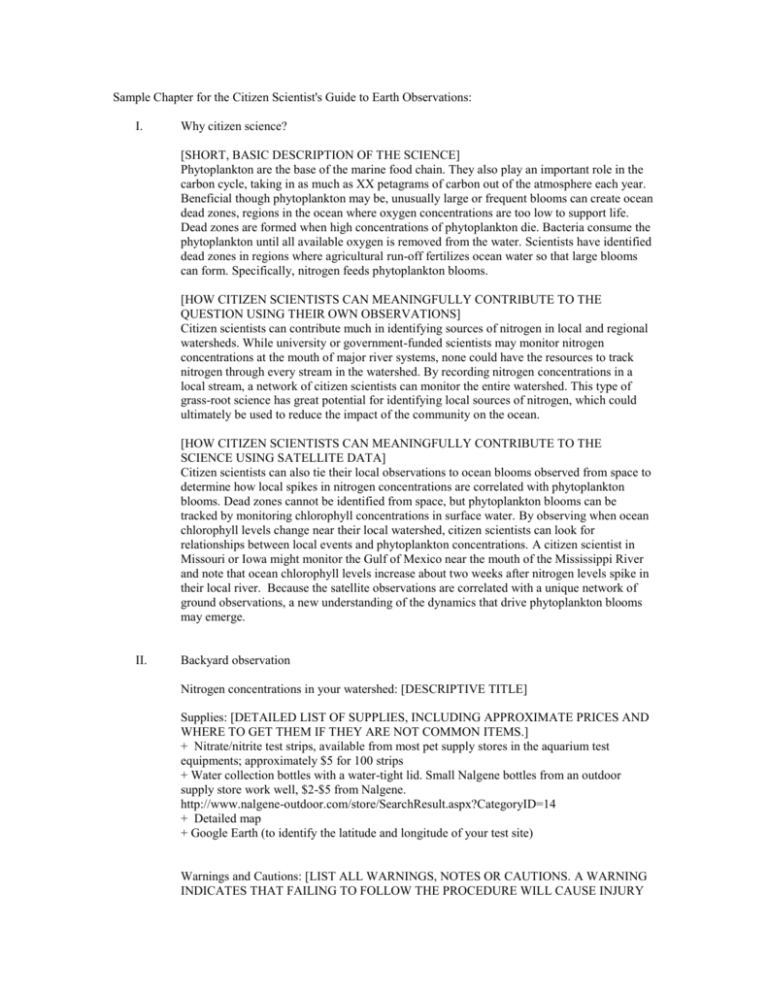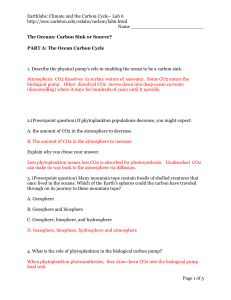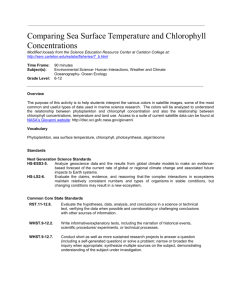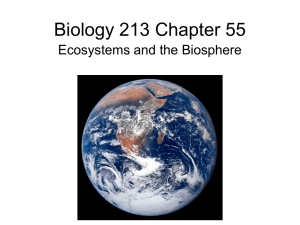Sample Chapter for the Citizen Scientist`s Guide to
advertisement

Sample Chapter for the Citizen Scientist's Guide to Earth Observations: I. Why citizen science? [SHORT, BASIC DESCRIPTION OF THE SCIENCE] Phytoplankton are the base of the marine food chain. They also play an important role in the carbon cycle, taking in as much as XX petagrams of carbon out of the atmosphere each year. Beneficial though phytoplankton may be, unusually large or frequent blooms can create ocean dead zones, regions in the ocean where oxygen concentrations are too low to support life. Dead zones are formed when high concentrations of phytoplankton die. Bacteria consume the phytoplankton until all available oxygen is removed from the water. Scientists have identified dead zones in regions where agricultural run-off fertilizes ocean water so that large blooms can form. Specifically, nitrogen feeds phytoplankton blooms. [HOW CITIZEN SCIENTISTS CAN MEANINGFULLY CONTRIBUTE TO THE QUESTION USING THEIR OWN OBSERVATIONS] Citizen scientists can contribute much in identifying sources of nitrogen in local and regional watersheds. While university or government-funded scientists may monitor nitrogen concentrations at the mouth of major river systems, none could have the resources to track nitrogen through every stream in the watershed. By recording nitrogen concentrations in a local stream, a network of citizen scientists can monitor the entire watershed. This type of grass-root science has great potential for identifying local sources of nitrogen, which could ultimately be used to reduce the impact of the community on the ocean. [HOW CITIZEN SCIENTISTS CAN MEANINGFULLY CONTRIBUTE TO THE SCIENCE USING SATELLITE DATA] Citizen scientists can also tie their local observations to ocean blooms observed from space to determine how local spikes in nitrogen concentrations are correlated with phytoplankton blooms. Dead zones cannot be identified from space, but phytoplankton blooms can be tracked by monitoring chlorophyll concentrations in surface water. By observing when ocean chlorophyll levels change near their local watershed, citizen scientists can look for relationships between local events and phytoplankton concentrations. A citizen scientist in Missouri or Iowa might monitor the Gulf of Mexico near the mouth of the Mississippi River and note that ocean chlorophyll levels increase about two weeks after nitrogen levels spike in their local river. Because the satellite observations are correlated with a unique network of ground observations, a new understanding of the dynamics that drive phytoplankton blooms may emerge. II. Backyard observation Nitrogen concentrations in your watershed: [DESCRIPTIVE TITLE] Supplies: [DETAILED LIST OF SUPPLIES, INCLUDING APPROXIMATE PRICES AND WHERE TO GET THEM IF THEY ARE NOT COMMON ITEMS.] + Nitrate/nitrite test strips, available from most pet supply stores in the aquarium test equipments; approximately $5 for 100 strips + Water collection bottles with a water-tight lid. Small Nalgene bottles from an outdoor supply store work well, $2-$5 from Nalgene. http://www.nalgene-outdoor.com/store/SearchResult.aspx?CategoryID=14 + Detailed map + Google Earth (to identify the latitude and longitude of your test site) Warnings and Cautions: [LIST ALL WARNINGS, NOTES OR CAUTIONS. A WARNING INDICATES THAT FAILING TO FOLLOW THE PROCEDURE WILL CAUSE INJURY OR DEATH. A CAUTION IS USED WHEN NOT FOLLOWING THE PROCEDURE WOULD BIAS THE RESULTS.] Warning: Do not take measurements during a severe storm or flood. Caution: Rinse the collection bottle in the stream before collecting water to decrease sample contamination. Sampling Procedure: [PROVIDE DETAILED INSTRUCTIONS. WHEN APPROPRIATE, EXPLAIN WHY A CERTAIN STEP IS IMPORTANT. REPEAT RELEVANT WARNINGS IN THE STEP TO WHICH THEY PERTAIN.] + Using the map, identify water collection points at various places in your region. Choose locations that are publicly accessible or where you have permission from the land owner to access. + Locate the sampling location in Google Earth. Place the cursor over the sampling site and note the latitude and longitude that appears in the bottom left corner of the Google Earth window. + Go to the sample location. Carefully note landmarks or other identifying features near the location in enough detail that you can return to the exact same location for later observations. + Note the condition of the stream or river. What is the condition of the river bottom? Is it silt or rock? Are there drainage pipes nearby? + Note conditions along the river bank. Is the river bank rock or mud? Is the bank steeply sloped? Are there plants near the bank? What kind of plants are they? How far away are they? Plants can slow run off and limit the amount of nitrogen that enters the water in a particular location. On the other hand, if the waterway borders on a field of crops or a lawn, excess nitrogen may enter the water from fertilizers. Careful notes about the conditions around the stream may help you determine why nitrogen levels fluctuate. + Note the time and date + Note weather conditions. + Label the sample bottle so that you can identify the sample later. + Rinse the collection bottle in the stream. CAUTION: If you do not rinse the collection bottle before sampling, the sample may be contaminated, and you will not get good results. + Fill the bottle with water from the river. Note the location so that every sample comes from the same part of the river. WARNING: Do not take samples when the National Weather Service has issued a severe storm or flood warning for the region. + Repeat the procedure for each location Testing Procedure: + Follow the directions on the test strip kit to record nitrate/nitrite levels in the water. Explain how test strips work; why you're testing for nitrate/nitrite; and describe related tests (ammonia). + Record the nitrate level in (units) and the uncertainty indicated by the test strip manufacturer in a data sheet. + Enter the date, time, and location (latitude and longitude) for the sample + Enter notes on weather and stream conditions You want to make your notes uniform so that it is easy to compare your observations with those made by another scientist. See "Sharing data" for information about how to share your results. Going Further: [DESCRIBE RELATED OBSERVATIONS THAT MIGHT BE USEFUL] Other observations that might be made with the sample; related measurements (rainfall, temperature, etc.) III. Earth Observation Monitor chlorophyll concentrations near major river systems connected to your watershed. [DESCRIPTIVE TITLE] Data description: [DESCRIPTION OF THE DATA SET USED IN THE STUDY] Define chlorophyll concentration data. What is it, how is it measured in very basic terms. Describe basic patterns in a typical image. Annotated image? Define uncertainties in data. Accessing data: [INSTRUCTIONS ON HOW TO ACCESS THE SATELLITE DATA, INCLUDING DIAGRAMS/SCREEN SHOTS] You can access data in Giovanni or NEO. The two tools are similar, you may try both and decide which you are most comfortable using. Any differences? Step-by-step instructions with diagrams for accessing data in Giovanni: Step-by-step instructions with diagrams for accessing data in NEO: + Go to neo.sci.gsfc.nasa.gov + Click on the ocean tab, beneath the map on the left + Select "chlorophyll concentration (MODIS). The most recent monthly image will load. + Under "matching datasets" in the right column, select "Chlorophyll Concentration (1 day Aqua/MODIS)" + Select the day + Click "analyze this image" Etc… Analyzing data: [INSTRUCTIONS ON HOW TO USE THE TOOL TO ANALYZE THE DATA. DEFINE THE END GOAL UP FRONT] In this analysis, you will determine the average chlorophyll value in mg/cubic meter in an ocean area near your watershed. Step-by-step instructions for analyzing data in NEO or Giovanni + Record average chlorophyll value Related datasets: [DESCRIBE SATELLITE DATASETS THAT MIGHT PROVIDE ADDITIONAL INSIGHT] Describe related data sets with links to the data sheet. Give examples of the sorts of relationships that might be tracked. (Sea surface temperature, rainfall, etc.) Going Further: [CONNECTING THE SATELLITE ANALYSIS AND THE GROUND OBSERVATIONS; RELATED QUESTIONS] Correlate backyard observations and satellite observations… Are chlorophyll concentrations correlated with rainfall upstream? Temperature? Related questions that could be addressed with satellite data IV. Share your results [SAME FOR ALL CHAPTERS; RESOURCES FOR CITIZEN SCIENCE GROUPS, DATA SHARING SYSTEMS] Identify Society for Amateur Scientists, other data-sharing opportunities. Maryland science center data sheet?? V. Tools and data quick reference [LIFT SUPPLIES AND DATA AND TOOLS SECTIONS FROM BACKYARD OBSERVATIONS AND EARTH OBSERVATION SEGMENTS; PROVIDE ADDITIONAL BACKGROUND INFORMATION IF APPROPRIATE, INCLUDE DATA SHEETS] Supplies for backyard research: Additional background information on the tools used Data and tools for Earth observation: Data sheets, links to additional information on the data sets or tools VI. Additional Resources [BACKGROUND MATERIAL, FURTHER READING ON TOPIC] References and links to background material like science papers, popular science articles on the topic










